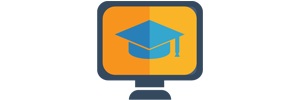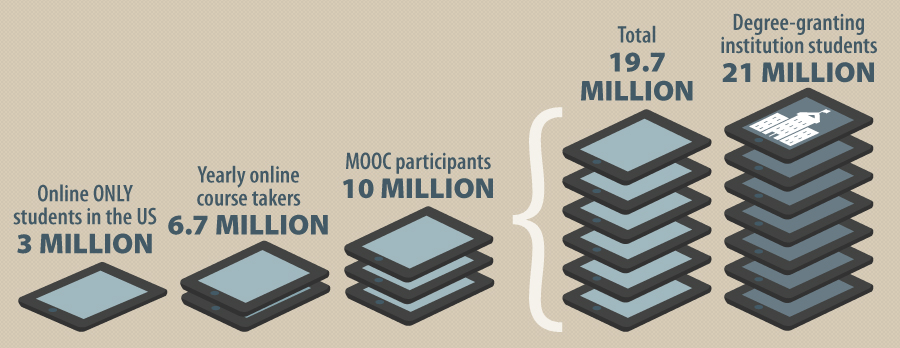Plug into the right news sources and you hear the hype every day. Education is being democratized, modularized, and generally parceled out in more and more flexible ways. While distance learning has been around for some time, it wasn’t until the modern web was developed, with the ability to share a variety of content types rapidly, that online learning came into its own. With a larger share of post-secondary students taking online classes every year, the future of online education has shifted from a theory to an increasingly bright certainty. Let’s check out some of the largest trends emerging in online education.
Transparency and Accountability Online
As of today, roughly as many students are enrolled in fully-online programs, one or more classes online, or MOOCs (massively open online courses) as are enrolled in post-secondary education as a whole. While these numbers don’t account for “double dipping,” or the number of students both enrolled in traditional post-secondary learning environments and taking courses online, they do present the possibility of a rapidly approaching date in which a large majority of classes will be taken online. Perhaps the largest component of more massive future adoption is — at this point — a unique strength and stumbling block for future online learning: transparency.
Transparency helps build trust, and lets employers and students know what they’re getting from a relatively new form of education. Anti-cheating policies, as well as quality control are two of the largest subsets of transparency in online education. And they’re both being dealt with in innovative ways.
In some ways, simply delivering course content online leads to greater transparency. Traditional course interactions can be hard to track, particularly outside of the classroom. Online education, however, leaves a trail of interactions (chat, video chat, on forums, and in email) enabling greater quality assurance testing. While for many our digital trails are a source of trepidation, for the sake of online education they offer access to a variety of valuable and measurable data relating to course presentation, student engagement, and instruction quality. As time goes on and online course providers can gather more data, greater insights into our actions in education online can be mined. In short, online education allows us to learn what works and what doesn’t more rapidly. Iterations of online education programs have the ability to cycle much faster than traditional education models.
[Tweet “Online education allows us to learn what works and what doesn’t more rapidly.”]
Anti-cheating mechanisms are an area of online education transparency that is rapidly developing. MOOC platforms now offer several measures with the aim of preserving the integrity and value of classes. An example from Coursera includes the chance to complete courses for certification. Coursera analyzes certified users’ typing patterns to verify identity, and thus preserves the integrity of coursework. For an additional (yet very modest) fee, four Coursera courses are now offered for college credit with the use of webcams for proctored final exams. This development shows the rapid growth in trust towards the quality of online instruction and gives a cue as to future developments. As trust in online education grows, not only will online courses from traditional universities continue to grow in popularity, but the distinction between open education platforms (like MOOCs) and online course from degree-granting institutions will continue to be blurred.
Role of the Instructor
New Ways to Collaborate
A second component of growth in online education centers on the revised role of instructors in education models. With many popular MOOCs exceeding 100,000’s of students, getting wait-listed for a superstar professor’s class might soon be a thing of the past. While subject matter certainly matters for course popularity, the entertainment factor brought by gifted instructors has the ability to truly shine in the realm of viral content. Similarly to Yahoo!’s talks with Ryan Seacrest and Matt Damon over creating educational content, the intersection of online education and viral content will continue to blur over time.
With the shift towards online delivery methods, the role of instructor within a given class has changed as well. “Flipping the classroom” is a process coined by Khan Academy (one of the larger MOOC providers). Where traditional classes involve teaching in the classroom and reiteration of concepts or introductions to new topics in homework, online education flips this on its head. “Flipping the classroom” gives students the curated materials through which they can teach themselves, and reinforces key information through in-class interactions (role-playing, mock applications of concepts, and exercises).
[Tweet “The entertainment factor brought by gifted instructors has the ability to truly shine in the realm of viral content.”]
While MOOCs will most likely not overtake traditional education models on their own, they will inform a new series of educational tracks focusing on providing value and skill-based outcomes for cheap. A byproduct of an increase in the number of courses that can reach large audiences efficiently (cheaply, quickly, without many barriers of entry), is that less highly specialized teachers will be necessary for instructional purposes. The two-track system between more expensive and traditional residential colleges and efficient but potentially more impersonal online classes and education models will bifurcate further. While access to education will increase, teaching positions required for number of students will decrease below current levels, further skewing higher education to skills-based training, and rewarding a very certain type of teacher.
New Frontiers
A broad range of institution types are chosen by online students. This signals a need for greater accessibility and online offerings for those with school-type preferences across the spectrum (private, public, for-profit, not-for-profit, research, liberal arts). Of online students, 65% attend not-for-profit schools (with the remaining attending for-profit); of not-for-profit colleges, 20% of online students attend private colleges, and 80% attend public schools.
The broad way in which online education is bring applied to students at a variety of institution types is a good sign for online education moving forward. This shows a paradigm-shifting event in education, rather than a soon bypassed trend of a certain type of school.
A much broader frontier than expanded US markets for education involve the largely mobile-internet ready developing world. With 50% of India, 38% of China, and up to 70% of Northern African states like Egypt mobile ready, exponentially larger audiences are ready for online learning outside of the West. Skill-based learning is at a premium, as seen by India’s already large and successful Institutes of Technology (many of which already provide online learning opportunities). With instruction in a variety of languages already available, be prepared to see institutions of varying nationalities increase their online presence dramatically in coming years.
The capabilities of smart phones also ideally complement what works best in online education. Two-way video chat has been found to increase student engagement 86% over traditional chatrooms. Effective online learning environments often rely on quick research, photo sharing, and collaboration through a variety of chat channels–all familiar processes for modern mobile users. Collaborative annotations of text, and periodic updates on work are well suited for mobile environments in which course work can be digested a bit a time throughout the day. However you cut it, there are tons of elements currently coming together to ensure the coming success of online education, whether formal (for-credit), tutorials and viral content, or MOOCs.
[Tweet “Two-way video chat has been found to increase student engagement 86% over traditional chatrooms”]
Happy learning!
Citations:
- http://www.npr.org/blogs/ed/2014/05/29/316989869/the-future-of-online-ed-isnt-heading-where-you-expect
- http://nces.ed.gov/fastfacts/display.asp?id=98
- http://www.cic.edu/Research-and-Data/Research-Studies/Documents/Online-Learning-Report-2013.pdf
- https://www.edsurge.com/n/2013-12-22-moocs-in-2013-breaking-down-the-numbers
- http://online.wsj.com/news/articles/SB10001424052702303825604579515521328500810
- http://gettingsmart.com/2014/02/future-online-learning-age-mobile-first-education/
- http://chronicle.com/blogs/profhacker/using-iannotate-as-a-grading-tool/53981?cid=at&utm_source=at&utm_medium=en
- http://www.itu.int/net/pressoffice/press_releases/2014/23.aspx#.U_ePmPldVfU



